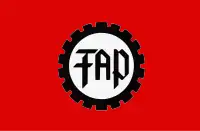Free German Workers' Party
The Free German Workers' Party (German: Freiheitliche Deutsche Arbeiterpartei; abbreviated FAP) was a neo-Nazi political party in Germany. It was outlawed by the Federal Constitutional Court in 1995.
Free German Workers' Party Freiheitliche Deutsche Arbeiterpartei | |
|---|---|
| Abbreviation | FAP |
| Leader | Michael Kühnen (1979–1989) Friedhelm Busse (1989–1995) |
| Founded | 1979 |
| Banned | 24 February 1995 |
| Headquarters | Bonn, Federal Republic of Germany |
| Membership (1987) | 500 |
| Ideology | Strasserism Neo-Nazism |
| Political position | Far-right |
| Colors | Red, black and white |
| Party flag | |
 | |
History
The FAP was founded in 1979 but was largely insignificant until the banning of the Action Front of National Socialists/National Activists in 1983 when Michael Kühnen encouraged members to infiltrate this tiny group. A minor party (around 500 members in 1987) it experienced something of a growth after German reunification and sought, unsuccessfully, an alliance with the National Democratic Party.[1] It contested the 1987 federal election and the 1989 European elections although in both instances it attracted negligible support.[2]

Associated with Strasserism, the FAP party managed to gain some support amongst football hooligans but was damaged by Kühnen's homosexuality, and took a stand against him. The party continued under Friedhelm Busse from 1989 but it lost a number of members to new groups loyal to Kühnen, including the German Alternative (1989) and the National Offensive (1990).[4]
The party was outlawed by the Federal Constitutional Court on 24 February 1995.
References
- D. Childs, 'The Far Right in Germany Since 1945' in L. Cheles, R. Ferguson & M. Vaughan, The Far Right in Western and Eastern Europe, 1995, p. 301
- Paul Hainsworth, The Extreme Right in Europe and the USA, Pinter, 1992, p. 63
- Photos show use of this flag in the early 1990s
- C. T. Husbands, 'Militant Neo-Nazism in the Federal Republic of Germany in the 1990s' in L. Cheles, R. Ferguson & M. Vaughan, The Far Right in Western and Eastern Europe, 1995, p. 329